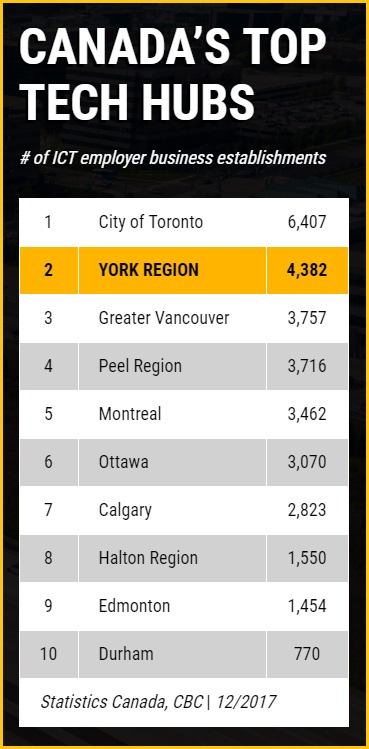
Part 1 | A Moment of Reflection for the Greater Toronto Area on Amazon HQ2 Locations
Part 2 | Urban Growth Outside of Downtown Cores: Should We Pay More Attention?
Part 3 | Tech in the GTA: A ‘Cluster of Clusters’ That Deserves Unpacking, Attention, and Promotion
** PART THREE OF A THREE PART SERIES **
In Part One, we looked at Amazon’s surprising selection of quasi-suburban redevelopment neighborhoods for its HQ2 locations, and raised the question of whether in light of that the GTA’s own urban transformation areas are getting the exposure they deserve.
Part Two presented a deeper dive into the significance of the GTA’s urban growth centres outside of the downtown core. We ended with the open question of whether areas in and around these successful centres also have what it takes when it comes down to attracting investments in the tech sector.
Greater Toronto’s tech sector is more like a cluster of clusters rather than a single hub

As this recent map from Neptis Geoweb shows, while there is a concentration of tech sector jobs in downtown Toronto, those jobs are, in fact, spread out across the GTA, with the most significant clusters located in Toronto’s downtown core, Markham and Richmond Hill in York Region (specifically highways 404/407 node), and in Mississauga (airport area).
Some areas in the GTA are home to secondary clusters, like the City of Toronto’s North York district, while others such as York Region’s City of Vaughan have a growing and increasingly significant B2B tech cluster to keep a close eye on.
These clusters are unique and can be differentiated along such lines as industry verticals, B2C or B2B focus, talent type needs and catchment areas, real estate types, cost of operations, brand vs. non-brand corporations, transit/vehicle accessibility, etc.; this alone could easily be a topic for a separate blog.
To add more context around the significance of GTA’s secondary tech hubs, York Region’s tech sector, for example, comprises 4,300 Information & Communications Technology (ICT) companies [employers] as per StatsCan data, second only to the City of Toronto in Canada. This includes both global enterprise-scale tech giants as well as some of Canada’s leading B2B tech scale-ups [more on this here].
The Region is also home to the highest labor force concentration of tech occupations in the Toronto-Waterloo corridor with almost 9% of the total, and also pulls in tens of thousands of reverse-commuters from nearby municipalities (mostly professionals living north of the 401).

As the table on the right shows, on a national scale the GTA’s York Region (primarily Markham, Vaughan, and Richmond Hill) and Peel Region (Mississauga and Brampton) not only represent a compelling share of GTA’s 16,000+ ICT business establishments, but each has a larger tech sector then most other municipal census divisions in Canada – other than the neighbouring City of Toronto.
So why does it matter and what’s the connection to Amazon’s HQ2 location choices, in a GTA context?
So what’s the bottom line considering the above? That a ‘cluster of clusters’ tech sector in a metro area of over 6.5 million residents, 250,000 business establishments, and 16,000 tech companies really warrants unraveling. Despite this, tech sector reports, media coverage, and promotional sector value propositions here in the GTA focus almost exclusively on one single ecosystem in the Toronto downtown.
Many of the bids received by Amazon from across North America pitched hip, downtown districts, home to brand names in tech, an energetic millennial workforce, and a brick-and-beam start-up scene happily coexisting alongside shiny glass corporate towers.
Yet to the surprise of many, Amazon chose for its massive HQ2 investment the quasi-suburban transforming neighborhoods of Long Island City, NY and Crystal City, Virginia. On the other hand, Canadian media coverage on GTA’s Amazon bid focused almost entirely on the downtown/waterfront area as the only viable location for Amazon in Toronto, and largely ignored other GTA tech hubs and urban growth centres as viable locations for major tech and corporate investments.
So to bring it full circle, let’s jump back to the question from Part One that kick-started this series. In light of Amazon’s surprising HQ2 location selections are the GTA’s own urban transformation areas outside the downtown core and their surrounding tech hubs getting the exposure and attention they rightfully deserve?
We’ll let you be the judge of that, but hope this three-part blog provided some food for thought.
– By the York Link Team
Part 1 | A Moment of Reflection for the Greater Toronto Area on Amazon HQ2 Locations
Part 2 | Urban Growth Outside of Downtown Cores: Should We Pay More Attention?
Part 3 | Tech in the GTA: A ‘Cluster of Clusters’ That Deserves Unpacking, Attention, and Promotion
